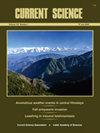Pigment Analysis of Palm Leaf Manuscripts of India
IF 1
4区 综合性期刊
Q3 MULTIDISCIPLINARY SCIENCES
引用次数: 1
Abstract
CURRENT SCIENCE, VOL. 118, NO. 2, 25 JANUARY 2020 285 *For correspondence. (e-mail: sharmadeepakshi1@gmail.com) 8. Malyoth, G. and Bauer, A., Observations on Bacterium bifidum. Z. Kinderhelikd., 1950, 68(4), 358. 9. Culpepper, T. et al., Bifidobacterium bifidum R0071 decreases stress associated diarrhoea-related symptoms and self-reported stress: a secondary analysis of a randomised trial. Benef. Microbes, 2016, 7(3), 327–336. 10. Saarela, M., Mogensen, G., Fonden, R., Mättö, J. and MattilaSandholm, T., Probiotic bacteria: safety, functional and technological properties. J. Biotechnol., 2000, 84(3), 197–215. 11. Siaterlis, A., Deepika, G. and Charalampopoulos, D., Effect of culture medium and cryoprotectants on the growth and survival of probiotic lactobacilli during freeze drying. Lett. Appl. Microbiol., 2009, 48, 295–301. 12. Veda, M. O., Nakamoto, S., Nakai, R. and Takagi, A., Establishment of a defined minimal medium and isolation of auxotrophic mutants for Bifidobacterium bifidum ES 5. J. Gen. Appl. Microbiol., 1983, 29(2), 103–114. 13. Gaden Jr, E. L., Fermentation process kinetics. Biotechnol. Bioeng., 2000, 67(6), 629–635. 14. Corre, C., Madec, M. N. and Boyaval, P., Production of concentrated Bifidobacterium bifidum. J. Chem. Technol. Biotechnol., 1992, 53(2), 189–194. 15. De Man, J. C., Rogosa, M. and Sharpe, M. E., A medium for the cultivation of lactobacilli. J. Appl. Bacteriol., 1960, 23, 130–135. 16. Vinderola, C. G. and Reinheimer, J. A., Culture media for the enumeration of Bifidobacterium bifidum and Lactobacillus acidophilus in the presence of yoghurt bacteria. Int. Dairy J., 1999, 9(8), 497–505. 17. Coghetto, C. C., Brinques, G. B., Siqueira, N. M., Pletsch, J., Soares, R. M. and Ayub, M. A., Electrospraying microencapsulation of Lactobacillus plantarum enhances cell viability under refrigeration storage and simulated gastric and intestinal fluids. J. Funct. Foods, 2016, 24, 316–326. 18. Meena, G. S., Gupta, S., Majumdar, G. C. and Banerjee, R., Growth characteristics modeling of Bifidobacterium bifidum using RSM and ANN. Braz. Arch. Biol. Technol., 2011, 54(6), 1357– 1366. 19. Dinakar, P. and Mistry, V. V., Growth and viability of Bifidobacterium bifidum in cheddar cheese. J. Dairy Sci., 1994, 77(10), 2854–2864. 20. Hekmat, S., Survival of Lactobacillus acidophilus and Bifidobacterium bifidum in ice cream for use as a probiotic food. J. Dairy Sci., 1992, 6, 1415–1422. 21. Kulkarni, S., Haq, S. F., Samant, S. and Sukumaran, S., Adaptation of Lactobacillus acidophilus to thermal stress yields a thermotolerant variant which also exhibits improved survival at pH 2. Probiot. Antimicrob. Proteins, 2018, 10(4), 717–727. 22. Hwang, C. F., Lin, C. K., Yan, S. Y., Chang, R. H. and Tsen, H. Y., Enhancement of biomass production and nutrition utilization by strain Lactobacillus acidophilus DGK derived from serial subculturing in an aerobic environment. Afr. J. Biotechnol., 2015, 14(3), 248–256. 23. Ram, C. and Chander, H., Optimization of culture conditions of probiotic bifidobacteria for maximal adhesion to hexadecane. World J. Microbiol. Biotechnol., 2003, 19(4), 407–410. 24. Mlobeli, N. T., Batch culture studies of Bifidobacterium bifidum: a thesis presented in partial fulfilment of the requirements for the degree of Master of Technology in Biotechnology and Bioprocess Engineering, Doctoral dissertation, Massey University, 1996. 25. Kwon, S. G., Son, J. W., Kim, H. J., Park, C. S., Lee, J. K., Ji, G. E. and Oh, D. K., High concentration cultivation of Bifidobacterium bifidum in a submerged membrane bioreactor. Biotechnol. Prog., 2006, 22(6), 1591–1597.印度棕榈叶手稿的色素分析
当代科学,第118卷,第118期。2、2020年1月25日(电子邮件:sharmadeepakshi1@gmail.com)Malyoth, G.和Bauer, A.《两歧杆菌的观察》。z Kinderhelikd。, 1950, 68(4), 358。9. Culpepper, T.等人,《两歧双歧杆菌R0071减少应激相关的腹泻相关症状和自我报告的应激:一项随机试验的二次分析》。Benef。微生物学报,2016,7(3),327-336。10. Saarela, M., Mogensen, G., Fonden, R., Mättö, J.和MattilaSandholm, T.,益生菌:安全性,功能和技术特性。生物科技j .》。中华医学杂志,2000,84(3),197-215。11. Siaterlis, A., Deepika, G.和Charalampopoulos, D.,培养基和冷冻保护剂对益生菌乳酸菌在冷冻干燥过程中的生长和存活的影响。列托人。达成。Microbiol。中文信息学报,2009,48,295-301。12. Veda, M. O., Nakamoto, S., Nakai, R.和Takagi, A.,两歧双歧杆菌ES 5最小培养基的建立和营养不良突变体的分离。j.g .苹果。Microbiol。, 1983, 29(2), 103-114。13. 发酵过程动力学。Biotechnol。Bioeng。中国生物医学工程学报,2000,67(6),629-635。14. Corre, C, Madec, M. N.和Boyaval, P.,浓缩两歧双歧杆菌的生产。j .化学。抛光工艺。Biotechnol。, 1992, 53(2), 189-194。15. De Man, J. C., Rogosa, M.和Sharpe, M. E.,一种培养乳酸菌的培养基。j:。Bacteriol。, 1960, 23, 130-135。16. Vinderola, c.g.和Reinheimer, j.a.,在酸奶菌存在的情况下,两歧双歧杆菌和嗜酸乳杆菌计数的培养基。Int。乳业杂志,1999,9(8),497-505。17. Coghetto, C. C., Brinques, G. B., Siqueira, N. M., Pletsch, J., Soares, R. M.和Ayub, M. A.,电喷雾微胶囊化植物乳杆菌在冷藏和模拟胃液和肠液下提高细胞活力。j .功能。食品科学,2016,24,316-326。18. Meena, G. S., Gupta, S., Majumdar, G. C.和Banerjee, R.,基于RSM和ANN的两歧双歧杆菌生长特性建模。布拉兹。拱门。医学杂志。抛光工艺。生态学报,2011,54(6),1357 - 1366。19. Dinakar, P.和Mistry, V. V.,两歧双歧杆菌在切达干酪中的生长和活力。乳品科学。中国生物医学工程学报,1994,37(10),2854-2864。20.嗜酸乳杆菌和两歧双歧杆菌在冰淇淋中作为益生菌食品的存活。乳品科学。, 1992, 6, 1415-1422。21. Kulkarni, S., Haq, S. F., Samant, S.和Sukumaran, S.,《嗜酸乳杆菌对热胁迫的适应性产生了耐热变体,该变体在pH 2下也表现出更高的存活率》。Probiot。Antimicrob。中国生物医学工程学报,2018,35(4):717-727。22. 黄春芳,林春奎,闫世勇,张仁华,曾海燕,嗜酸乳杆菌DGK在好氧环境中连续传代培养的生物量生产和营养利用。误判率。生物科技j .》。生态学报,2015,14(3),248-256。23. Ram, C.和Chander, H.,益生菌双歧杆菌对十六烷最大粘附的培养条件优化。世界微生物学。Biotechnol。中国机械工程,2003,19(4):407-410。24. Mlobeli, n.t.,《两歧双歧杆菌的批量培养研究:部分满足生物技术和生物工艺工程硕士学位要求的论文》,梅西大学,1996年博士论文。25. 权世光,孙建伟,金洪杰,朴正生,李建奎,池桂英,吴德康,两歧双歧杆菌在膜生物反应器中的高浓度培养。Biotechnol。掠夺。浙江农业学报,2006,22(6),1591-1597。
本文章由计算机程序翻译,如有差异,请以英文原文为准。
求助全文
约1分钟内获得全文
求助全文
来源期刊

Current Science
综合性期刊-综合性期刊
CiteScore
1.50
自引率
10.00%
发文量
97
审稿时长
3 months
期刊介绍:
Current Science, published every fortnight by the Association, in collaboration with the Indian Academy of Sciences, is the leading interdisciplinary science journal from India. It was started in 1932 by the then stalwarts of Indian science such as CV Raman, Birbal Sahni, Meghnad Saha, Martin Foster and S.S. Bhatnagar. In 2011, the journal completed one hundred volumes. The journal is intended as a medium for communication and discussion of important issues that concern science and scientific activities. Besides full length research articles and shorter research communications, the journal publishes review articles, scientific correspondence and commentaries, news and views, comments on recently published research papers, opinions on scientific activity, articles on universities, Indian laboratories and institutions, interviews with scientists, personal information, book reviews, etc. It is also a forum to discuss issues and problems faced by science and scientists and an effective medium of interaction among scientists in the country and abroad. Current Science is read by a large community of scientists and the circulation has been continuously going up.
Current Science publishes special sections on diverse and topical themes of interest and this has served as a platform for the scientific fraternity to get their work acknowledged and highlighted. Some of the special sections that have been well received in the recent past include remote sensing, waves and symmetry, seismology in India, nanomaterials, AIDS, Alzheimer''s disease, molecular biology of ageing, cancer, cardiovascular diseases, Indian monsoon, water, transport, and mountain weather forecasting in India, to name a few. Contributions to these special issues ‘which receive widespread attention’ are from leading scientists in India and abroad.
 求助内容:
求助内容: 应助结果提醒方式:
应助结果提醒方式:


